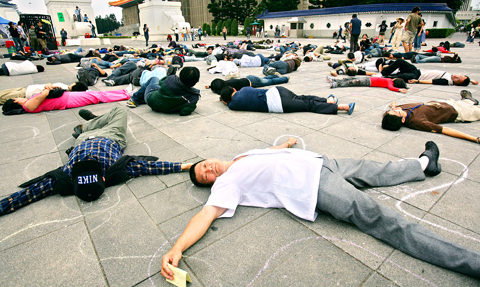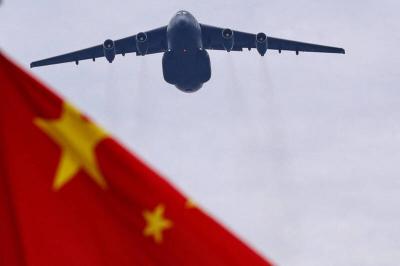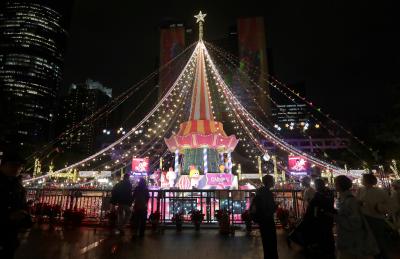The Wild Strawberry Student Movement held a mock “memorial service” yesterday for human rights at the National Taiwan Democracy Memorial Hall.
Wearing white head coverings and face masks, a few dozen protesters gathered at Liberty Square, carrying placards that read “Freedom of speech” and “Free from violence” and offering their “condolences” to rights they said have been trampled by the government.
The memorial service “symbolizes our sadness toward [the government’s] violations of human rights during [Association for Relations Across the Taiwan Strait Chairman] Chen Yunlin’s [陳雲林] stay in Taiwan,” said Lo Shih-hsiang (羅士翔), a spokesman for the movement.

PHOTO: CNA
The students began their silent sit-in on Nov. 6 to protest what they called excessive police force against demonstrators who opposed Chen’s visit between Nov. 3 and Nov 7.
After police removed the students from outside the Executive Yuan, they moved their demonstration to the square on Nov. 7.
The group has continued its demonstrations at the square every day, calling for immediate amendments to the Assembly and Parade Law (集會遊行法) to scrap regulations requiring police approval for demonstrations.
The students had sent out “notices of death” of the nation’s human rights to politicians across party lines, including President Ma Ying-jeou (馬英九), Premier Liu Chao-shiuan (劉兆玄), Chinese Nationalist Party (KMT) Chairman Wu Poh-hsiung (吳伯雄) and Democratic Progressive Party (DPP) Chairperson Tsai Ing-wen (蔡英文), and to National Police Agency Director-General Wang Cho-chiun (王卓鈞) and National Security Bureau Director-General Tsai Chao-ming (蔡朝明). Only Tsai attended the mock funeral.
When approached by reporters, Tsai said she wanted to encourage the students, but that she did not want their demonstration to be labeled as an activity organized by the pan-green camp.
Speaking on the assembly law, Tsai said the former DPP administration “failed to pay enough attention or push for amending or abolishing the Assembly and Parade Law. We feel very sorry.”
The students also expressed opposition yesterday to a requirement by the Ministry of Justice that schools nationwide recruit personnel to implement government ethics policies.
The ministry sent formal notices to all government branches asking schools, government agencies and state-run enterprises to recruit the personnel.
The move drew widespread criticism across party lines, with many legislators calling the measure reminiscent of the Martial Law era, when all schools had human resource units in charge of spying on public servants and reporting back to the ministry.
The DPP caucus said the ministry’s requirement may violate the 1992 Act Governing the Establishment of the Government Employee Ethics Units and Officers (政風機構人員設置條例), which says the legislature, local councils, military agencies and public schools do not need to establish such units.
“The students of the Wild Strawberry Student Movement are worried that schools ... will be threatened by the White Terror again,” the students said in a press release.

Beijing could eventually see a full amphibious invasion of Taiwan as the only "prudent" way to bring about unification, the US Department of Defense said in a newly released annual report to Congress. The Pentagon's "Annual Report to Congress: Military and Security Developments Involving the People's Republic of China 2025," was in many ways similar to last year’s report but reorganized the analysis of the options China has to take over Taiwan. Generally, according to the report, Chinese leaders view the People's Liberation Army's (PLA) capabilities for a Taiwan campaign as improving, but they remain uncertain about its readiness to successfully seize

Taiwan is getting a day off on Christmas for the first time in 25 years. The change comes after opposition parties passed a law earlier this year to add or restore five public holidays, including Constitution Day, which falls on today, Dec. 25. The day marks the 1947 adoption of the constitution of the Republic of China, as the government in Taipei is formally known. Back then the Chinese Nationalist Party (KMT) governed China from Nanjing. When the KMT, now an opposition party in Taiwan, passed the legislation on holidays, it said that they would help “commemorate the history of national development.” That

Trips for more than 100,000 international and domestic air travelers could be disrupted as China launches a military exercise around Taiwan today, Taiwan’s Civil Aviation Administration (CAA) said yesterday. The exercise could affect nearly 900 flights scheduled to enter the Taipei Flight Information Region (FIR) during the exercise window, it added. A notice issued by the Chinese Civil Aviation Administration showed there would be seven temporary zones around the Taiwan Strait which would be used for live-fire exercises, lasting from 8am to 6pm today. All aircraft are prohibited from entering during exercise, it says. Taipei FIR has 14 international air routes and

Snow fell on Yushan (Jade Mountain, 玉山) yesterday morning as a continental cold air mass sent temperatures below freezing on Taiwan’s tallest peak, the Central Weather Administration (CWA) said. Snowflakes were seen on Yushan’s north peak from 6:28am to 6:38am, but they did not fully cover the ground and no accumulation was recorded, the CWA said. As of 7:42am, the lowest temperature recorded across Taiwan was minus-5.5°C at Yushan’s Fengkou observatory and minus-4.7°C at the Yushan observatory, CWA data showed. On Hehuanshan (合歡山) in Nantou County, a low of 1.3°C was recorded at 6:39pm, when ice pellets fell at Songsyue Lodge (松雪樓), a